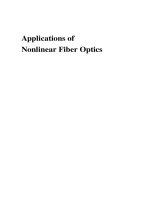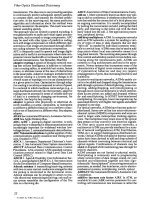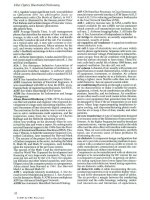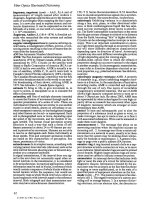Fiber optics transforms
Bạn đang xem bản rút gọn của tài liệu. Xem và tải ngay bản đầy đủ của tài liệu tại đây (287.72 KB, 4 trang )
Tu.C1.6
136
ICTON 2008
Fiber Optics Transforms
Michela Svaluto Moreolo, Associate Member, IEEE Gabriella Cincotti, Senior Member, IEEE
University Roma Tre, Via della Vasca navale 84, 00146 Rome, Italy
Tel: +39 06 57333349, Fax: +39 06 57337026, e-mail:
ABSTRACT
We give fiber or planar lightwave circuit (PLC) architectures to implement the Discrete Fourier Transform
(DFT) and the Discrete Hartley Transform (DHT) directly in the optical domain. In both cases, we present a
recursive approach for the decimation-in-frequency algorithm, considering parallel and serial input
configurations. We also describe PLC devices for high-speed optical filtering and data compression, based on
Discrete Wavelet Transforms (DWT) and Discrete Cosine Transform (DCT).
Keywords: discrete transforms, fiber optics, planar lightwave circuits, asymmetric couplers, optical signal
processing.
1. INTRODUCTION
Processing signals directly in the optical domain is a key requirement in high-speed transparent networks. In the
present paper, we give the design guidelines to implement the optical discrete Fourier transforms (DFT) and the
discrete Hartley transform (DHT) of order N, by using a recursive formulation. In the case of real valued signals,
DHT can advantageously replace standard DFT, as it requires simpler optical networks to performs power
spectra and convolutions. Wavelet transforms is a powerful and flexible tool for signal filtering and data
compression; we show that any discrete wavelet transform (DWT) or wavelet packet (WP) decomposition with
a compactly supported basis function can be synthesized by using passive optical networks of asymmetric
couplers. Finally, we present the synthesis procedure to design an optical discrete cosine transform (DCT) circuit
based on the DHT approach.
2. DISCRETE FOURIER AND HARTLEY TRANSFORMS
The Discrete Fourier and Hartley Transforms of a sequence of length N are
h(k ) =
N −1
1
∑ x ( n ) exp [ − j 2π kn / N ] ,
(1)
∑ x ( n ) ⎡⎣cos ( 2π kn / N ) + sin ( 2π kn / N )⎤⎦ ,
(2)
y (k ) =
N
n =0
N −1
1
N
n=0
respectively, and they can be expressed also by using a matrix formulation
y(N ) =
F(N )
N
x ( N );
y(N) =
T( N )
N
x(N ) .
(3)
The DFT and the DHT of order N = 2 are identical and coincide with the Walsh-Hadamard matrix of the same
order
⎡ y ( 0 )⎤
1 ⎡1 1 ⎤ ⎡ x ( 0 ) ⎤
⎢
⎥=
⎥,
⎢
⎥⎢
2 ⎣1 −1⎦ ⎣ x (1) ⎦
⎣ y (1) ⎦
(4)
that can be easily implemented by a 3dB coupler (see Fig. 1a).
According to the decimation-in-frequency algorithm, the FFT and FHT of order N can be recursively
evaluated starting from the N / 2-order transform. For the Fourier transform, we have
yˆ ( N ) =
⎡ I ( N 2)
I ( N 2) ⎤
1 ˆ
F ( N 2) ⎢
⎥ x(N ) ,
N
⎣G ( N 2 ) −G ( N 2 ) ⎦
where the symbol ^ indicates bit-reversed order, I ( N 2 ) is the
(5)
N 2 × N 2 identity matrix, and
G ( N 2 ) = Diag ⎡⎣exp ( − j 2π k / N ) ⎤⎦ . Equation (5) can be also used to evaluate the DHT, if we put
G ( N 2 ) = Diag ⎡⎣ cos ( 2π k / N ) ⎤⎦ + Diag ⎡⎣sin ( 2π k / N ) ⎤⎦ P ( N 2 ) , with
⎡1
⎤
⎢
⎥
1
⎥.
P ( N 2) = ⎢
⎢
$ ⎥
⎢
⎥
⎣ 1
⎦
978-1-4244-2626-3/08/$25.00 ©2008 IEEE
(6)
ICTON 2008
137
Tu.C1.6
Therefore DFT and DHT differs only for the P matrix, that in the case of FFT is a diagonal matrix with
imaginary elements –j.
The optical circuits to evaluate the DFT have been described in Ref. [1], and Ref. [2] reported the optical
networks to evaluate the DFT of a stream of optical digits. In Fig. 1 we describe the circuits for N = 2, 4, 8, that
can be easily extended to arbitrary order N by using equation (5); each architecture requires Y-branches, time
delays, that are multiples of the input sequence bit period τ, asymmetric couplers and phase shifters.
Figure 1. Optical networks to evaluate the DFT of a stream of optical pulses with length (a) N = 2, (b) N = 4,
(c) N = 8 and bit period τ. The boxes represent phase shifters of value –m2π/N, with m the number inside the
box; time delays are indicated with ellipses.
The network that implements the DHT, requires asymmetric couplers, but not phase shifters, since the elements
of G matrix are real. The DHT for N = 4, that coincides with the Walsh-Hadamard matrix of the same order, is
reported in Fig. 2, for both parallel and serial configurations. For N ≥ 8 , the even block can be synthesized by
using the FHT network of order N / 2, while the odd block requires an additional stage of asymmetric couplers,
as shown in Fig. 2c and 2d.
Tu.C1.6
138
ICTON 2008
Figure 2. Optical FHT circuits: parallel and serial configuration for N=4, (a), (b), and for N=8 (c), (d).
3. DISCRETE WAVELET TRANSFORM AND WP DECOMPOSITION
Wavelet signal decomposition can be performed directly in the optical domain for high-speed signal processing,
and any wavelet filter with compact support can be optically synthesized [3]. For different applications, different
wavelet functions and decomposition trees are possible. This flexibility makes wavelet processing suitable for
signal denoising and data compression. In fact, the detail coefficients can be thresholded or discharged and the
decomposition tree can be grown or pruned; moreover, different choices of the wavelet function allow us to
optimize the system performance.
WP decomposition gives a richer analysis, since not only the approximation coefficients but also the details
are analyzed at each decomposition level. Figure 3 shows the Haar or Daubechies wavelet of first order with
parallel input. Also architectures for serial input can be designed by using chains of Mach-Zehnder
interferometers (MZIs) [4].
Figure 3. (a) Optical Haar transform and (b) corresponding WP decomposition up to the third level.
4. DISCRETE COSINE TRANSFORM
DCT is another powerful tool for digital filtering, feature extraction and data compression, since the main signal
content compacts in the low indexed DCT elements. DCT can be evaluated with direct or indirect computation,
based on DFT or DHT [5]. To obtain simpler optical networks without the need of phase shifters, we furnish the
design guidelines by using DHT.
DCT can be recursively calculated starting from the DHT, after reordering the input elements and adding
a butterfly stage at the output [6]. In the case N = 2, the DCT coincides with DFT and DHT of the same order.
Figures 4a and 4b show the optical circuits that perform the DCT of order N = 4 and N = 8. Not only 50/50
beam splitters, but also asymmetric couplers with splitting rate 15/85, or 4/96 and 30/70 are required. A circuit
restatement is given in Fig. 4c and 4d.
ICTON 2008
139
Tu.C1.6
Figure 4. Optical DCT for N=4 (a) and N=8 (b), the grey boxes evidence the FHT circuits of the same order; (c)
and (d) corresponding simplified networks.
5. CONCLUSIONS
This paper furnishes the design guidelines to implement discrete transforms of arbitrary order directly in the
optical domain by using only lossless, single-mode, polarization-independent fibers and asymmetric couplers, or
planar lightwave circuits. Therefore, depending on the applications, it is possible to choose the suitable transform
for high-speed processing of an optical signal.
The optical circuits to recursively evaluate the DFT and the DHT is based on the decimation-in-frequency
algorithm and both parallel and serial configurations have been considered. Wavelet signal processing for highspeed applications can be performed by simple passive optical networks, any wavelet filter with compact support
can be optically synthesized and different wavelet schemes are possible; therefore, we are able to design flexible
optical architectures for digital filtering, denoising and data compression.
Finally we have furnished the synthesis procedure for the optical DCT, based on the DHT circuit of the same
order.
ACKNOWLEDGEMENTS
The work described in this paper was carried out with the support of the BONE-project (“Building the Future
Optical Network in Europe”), a Network of Excellence funded by the European Commission through the 7th
ICT-Framework Programme.
REFERENCES
[1] A. E. Siegman: Fiber Fourier optics, Opt. Lett., vol. 19, pp. 1215-1217, 2001.
[2] G. Cincotti: Fiber wavelet filters, IEEE J. of Quantum Electr., vol. 38, pp. 1420-1427, 2002.
[3] M. Svaluto Moreolo, G. Cincotti, A. Neri: Synthesis of optical wavelet filters, Photon. Technol. Letters,
vol. 16, pp. 1679-1681, July 2004.
[4] M. Svaluto Moreolo, G. Cincotti: Compact low-loss planar architectures for all-optical signal processing,
in Proc. ICTON 2005, Barcelona, Spain, July 2005, paper Tu.B2.7.
[5] P. Lee, F. Huang: Restructured recursive DCT and DST algorithms, IEEE Trans. Signal Processing,
vol. 42, pp. 1600-1609, 1994.
[6] H. S. Hou: The fast Hartley transform algorithm, IEEE Trans. Computers, vol. C-36, pp. 147-156, 1987.









